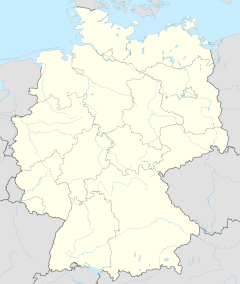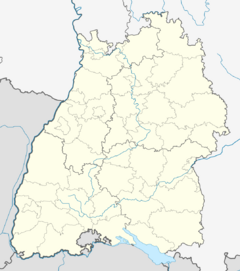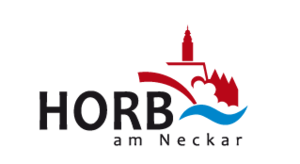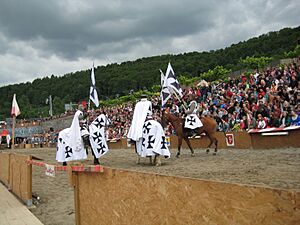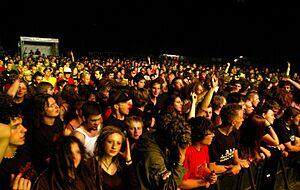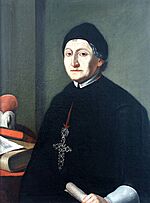Horb am Neckar facts for kids
Quick facts for kids
Horb am Neckar
|
||
|---|---|---|
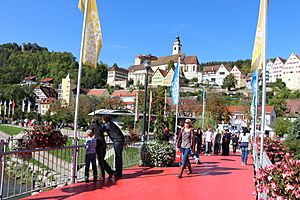 |
||
|
||
|
Location of Horb am Neckar within Freudenstadt district
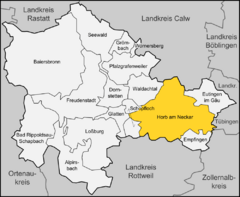 |
||
| Country | Germany | |
| State | Baden-Württemberg | |
| Admin. region | Karlsruhe | |
| District | Freudenstadt | |
| Area | ||
| • Total | 119.84 km2 (46.27 sq mi) | |
| Elevation | 437 m (1,434 ft) | |
| Population
(2022-12-31)
|
||
| • Total | 25,752 | |
| • Density | 214.887/km2 (556.55/sq mi) | |
| Time zone | UTC+01:00 (CET) | |
| • Summer (DST) | UTC+02:00 (CEST) | |
| Postal codes |
72160
|
|
| Dialling codes | 07451, 07482, 07483, 07486 | |
| Vehicle registration | FDS, HCH, HOR, WOL | |
| Website | www.horb.de | |
Horb am Neckar is a town in the southwest of Germany. It is located in the state of Baden-Württemberg, right on the Neckar river. The town is about 56 kilometers west of Offenburg and 29 kilometers east of Tübingen.
About 25,000 people live in Horb am Neckar. Around 6,000 of them live in the main town. The rest live in 18 smaller villages and areas that are part of the same town. Horb is the largest town in the Freudenstadt District when you count all its parts.
Since 1981, Horb am Neckar has been a Große Kreisstadt. This means it's a larger town that helps serve the surrounding area. It is part of the Northern Black Forest Region. Horb also works closely with the nearby towns of Empfingen and Eutingen im Gäu.
Contents
Geography of Horb
Horb is located on the eastern edge of the northern Black Forest. The old part of town is very well-preserved. It sits on a ridge overlooking the Neckar river. Here you can find an old castle, castle gardens, and a typical market square with the town hall. The newer parts of Horb stretch into the valleys of the rivers.
Parts of Horb
Horb am Neckar includes many smaller communities. These communities have their own elected councils. Some of these are Ahldorf, Altheim, Betra, Bildechingen, Bittelbronn, Dettensee, Dettingen, Dettlingen, Dießen, Grünmettstetten, Ihlingen, Isenburg, Mühlen, Mühringen, Nordstetten, Rexingen, and Talheim. Talheim itself is made up of two older communities, Obertalheim and Untertalheim. For mail, these places are called Horb-Ahldorf, Horb-Altheim, and so on.
There are also other areas with names like Hohenberg and Haugenstein. Plus, many tiny hamlets with just a few homes. These include places like Fronholzhof and Ziegelhof.
Neighboring Towns
Horb am Neckar shares borders with several other towns and communities. These include Eutingen im Gäu, Starzach, Haigerloch, Empfingen, Sulz am Neckar, Glatten, Schopfloch, and Waldachtal. It also borders Haiterbach and Nagold.
History of Horb
Horb was first mentioned in official papers in 1090. Its name, horv or horva, meant "swamp" in an old German language. People think Horb is even older than 1090 because that language was already fading out then.
The land near the Neckar river was swampy. So, the town was built on the hills of the Schütteberg mountain. This is why the old town sits high up and can be seen from far away.
Horb was officially called a town in 1228. The first mentions of a mayor and a market appeared a bit later. Until 1305, Horb belonged to the counts palatine of Tübingen. Then, it became part of the counts of Hohenberg. In 1381, Horb became part of Austria. It was an important administrative center there.
Later, in 1806, Horb joined the Kingdom of Württemberg. It became a local administrative center called Oberamt Horb. Its borders changed over time. In 1938, it became a rural district, Landkreis Horb.
Some of Horb's current communities, like Betra and Dettensee, were part of a different area called the Principality of Hohenzollern-Sigmaringen since 1803. In 1973, many local government areas in Baden-Württemberg were reorganized. Most of Horb's land, including the town itself, moved to the Freudenstadt District. This district is now part of the Northern Black Forest Region.
In 1979, Horb's population grew to over 20,000 people. This allowed the town to ask the state government to become a major district town (Große Kreisstadt). This request was approved, and Horb gained this status on January 1, 1981.
Religion in Horb
In the Middle Ages, Horb am Neckar was part of the Bishopric of Constance. When the Protestant Reformation happened, Horb was still part of Austria. Because of this, most people in Horb remained Catholic. When Horb became part of the Kingdom of Württemberg, it joined the Diocese of Rottenburg. Today, this is the Roman Catholic Diocese of Rottenburg-Stuttgart.
Today, there are two main Catholic groups in Horb. One is called Seelsorgeeinheit Steinachtal. It includes churches in Altheim, Grünmettstetten, and Talheim. The other is Seelsorgeeinheit Horb. It includes churches in Horb itself, Ihlingen, Isenburg, and other nearby places. Some communities like Betra and Dettensee belong to a different Catholic area, the Roman Catholic Archdiocese of Freiburg. This is because of their past history.
In the 1800s, Protestants (Lutherans) also moved to Horb. In 1866, they formed their first church group. Later, they built their own church, the Johanneskirche (St. John's). The Protestant community in Horb is part of the Sulz am Neckar district. It includes members from Horb and nearby towns like Eutingen im Gäu. Other Protestant groups exist in different parts of Horb, like Dettingen and Mühlen.
Besides the main Christian churches, there are also other Christian groups. These include a Pentecostal church and a New Apostolic Church.
Horb and its communities also had several Jewish communities in the past. Sadly, during the Nazi era, many Jewish people were forced to leave or were deported. Jewish communities were found in Rexingen, Nordstetten, and Baisingen.
Coat of Arms
The coat of arms for Horb am Neckar has a shield split into two halves. The top half is silver, and the bottom half is red. In the 1200s, the counts palatine of Tübingen helped Horb become a town. The oldest town seal from 1261 shows their family's symbols.
In 1305, Horb was taken over by the counts of Hohenberg through a marriage. Since then, the town has used the Hohenberg family's symbols. The oldest town seal with these symbols is from 1308.
Economy and Life in Horb
Tourism is very important for Horb am Neckar. Many local groups work to promote the town's events and attractions. These often include concerts, comedy shows, and plays.
One big event is the annual Renaissance fair called "Maximilian-Ritterspiele." This "Maximilian jousting" festival happens in mid-June. It brings in many visitors from all over the region. Horb also hosts the "Mini Rock Festival." This festival attracts thousands of people each year and features music from around the world. Since 2005, teenagers have mostly organized and run this festival.
The largest employer in Horb is the engineering company Bosch Rexroth. They have a factory in the town. Other companies in Horb include the manufacturers Fischer and LEUCO. Most of Horb's factories are in the areas of Heiligenfeld or Hohenberg.
Local daily newspapers include the "Neckar-Chronik" edition of Südwest Presse and a Horb edition of the Schwarzwälder Bote.
Main Sights
- The yearly Renaissance fair "Maximilian-Ritterspiele" (Maximilian-Jousting) in Horb takes place in mid-June.
- The yearly Rock festival "Mini-Rock-Festival" happens in late August. Teenagers have organized it voluntarily since 2005.
Notable People
- Georgius Eberhard (around 1490), an abbot at the St. Blasien monastery.
- Veit Stoss (1447–1533), a famous sculptor, painter, and engraver.
- Sebastian Lotzer (around 1490 – died unknown), an author during the Peasant War.
- Christina Rauscher (1570–1618), an official who spoke out against witch trials.
- Martin Gerbert (1720–1793), a Prince Abbot of St. Blasien.
- Kaspar Kaltenmoser (1806–1867), a painter known for everyday scenes.
- Berthold Auerbach (1812–1882), a well-known writer.
- Johann Nepomuk Meintel (1816–1872), a sculptor and painter.
- Johann Nepomuk Brischar (1819–1897), a Catholic church historian.
- Wilhelm Erath (1820–1908), a merchant and mayor of Horb from 1874 to 1899.
- Paul Leopold Haffner (1829–1899), a Bishop of Mainz.
- Paul Schanz (1842–1905), a Catholic theology professor.
- Maximilian Berlitz (1852–1921), who started the Berlitz language schools.
- Lorenz Bock (1883–1948), President of Württemberg-Hohenzollern.
- Georg Mayer (1892–1973), an economist and university rector.
- Eberhard Gönner (1919–2012), a historian.
- Franz Blank (1925–2008), a long-time council chairman and board member of Porsche AG.
- Norbert Schneider (born 1935), a lawyer and politician.
- Johannes Kreidler (born 1946), an auxiliary bishop.
- Carmina Brenner (born 1957), a politician and head of the State Statistical Office.
- Pascal Reinhardt (born 1992), a football player.
- Kwadwo Baah (born 2003), a football player.
People Connected to Horb
- Berthold Auerbach was a novelist and poet who had ties to the town.
- Michael Jung is a German equestrian who won two Olympic gold medals in 2012.
International Friends
Horb am Neckar has special friendship agreements with other towns around the world. These are called "twin towns" or "sister cities":
 Haslemere, Surrey, United Kingdom, since 1991.
Haslemere, Surrey, United Kingdom, since 1991. Salins-les-Bains, France, since 1991.
Salins-les-Bains, France, since 1991. Sant Just Desvern, Catalonia, Spain, since 1999.
Sant Just Desvern, Catalonia, Spain, since 1999.
See also
 In Spanish: Horb am Neckar para niños
In Spanish: Horb am Neckar para niños



